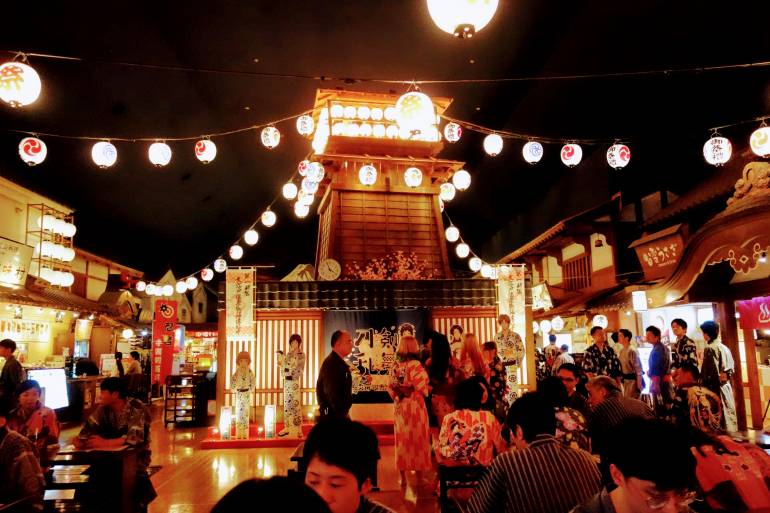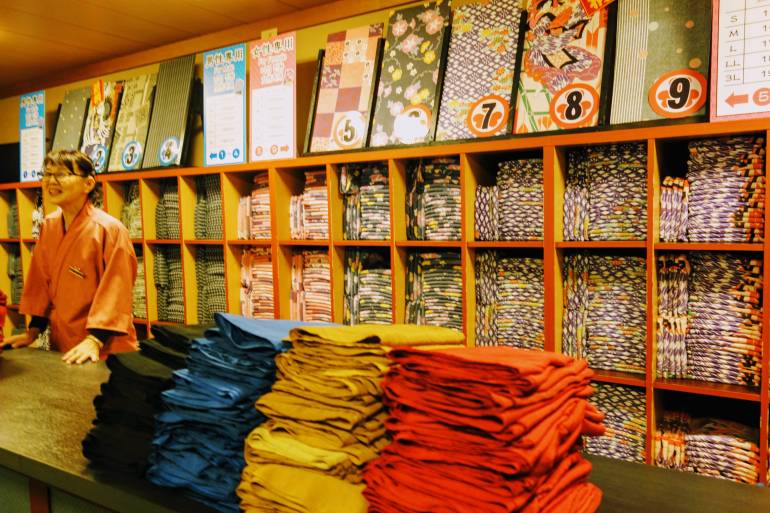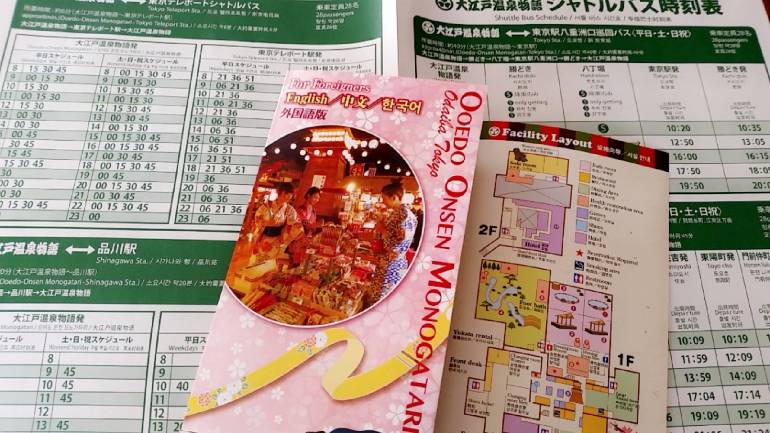There are onsen, and then there’s Odaiba Oedo Onsen Monogatari. Sometimes you just want a quick relaxing soak before heading home, sometimes you want a weekend hot spring escape and sometimes you want to wander around an Edo-period hall in a yukata, eating crepes and ignoring your real-world problems for hours. If you’re ever in need of the latter (and who isn’t?), this is the place for you.

With everything from foot baths to festival games, ramen to rotenburo, Odaiba Oedo Onsen Monogatari has enough to keep you occupied for a relaxing day out, but doesn’t come cheap. That said, there are ways to save on your visit (keep reading), and if you spend a good amount of time here, you can make it worth your while—especially on a cold rainy day!
Getting started: Stepping back in time
Ok, so you might be stepping back in time, but you’re taking an electronic barcode wristband and lots of rules with you. If you follow these steps, a relaxing soak and stroll awaits.

When you arrive, take off your shoes and place them in a locker, put the key somewhere safe and head over to the check-in desks. You don’t pay yet, you just take a wristband with another key and a barcode, then go to the yukata (light kimono) stand.
Here, you can choose from a selection of yukata and obi (belts), with half for men and half for women. They are numbered and sorted into sizes depending on height, so it’s pretty easy.
Finally, you can head into the first changing room where you find your locker (identified by number on barcode key), strip down to underwear, don the yukata (many, many guides provided to explain how), stash your belongings and head in to the main hall. You can take a small bag with your phone or camera, etc., and any bath products or makeup you want to use—there will be another locker later.
You also do not need any money, everything is paid for using your wristband—beware of running up a big tab though, it’s easily done!
Bathing at Odaiba Oedo Onsen Monogatari
The actual onsen entrance can be found to the left of the wooden tower with a smart-looking desk—it’s also where you can discuss additional spa treatments. Finally, you can soak! (If you’re not au fait with onsen— here’s our etiquette guide).
You’ll enter another changing room where you are given two towels and pick a locker to store your stuff, then get naked. Take a quick rinse at the entrance, then take a seat at a shower booth and scrub the real world away with the complimentary shampoo, conditioner, body wash and facial cleanser. There are a selection of different baths, including jet pools, oxygen bubble baths and open-air barrel baths, with large indoor and outdoor sections and a steam sauna.
It can get quite busy, but there are always spaces opening up, and it’s fun to try all the different ones. The outdoor area is great for cooling off in colder months and there are cold standing showers available for when it’s as hot outside as it is in! You can come and go between then hall, footbath area and onsen as you like, just change back into your yukata, drop off your towels and head in.
The Edo-period extras: Eats and atmosphere
The hall is a pretty impressive sight—designed to recreate the atmosphere of a traditional Japanese summer festival, it has lanterns, street food, games … and with everyone in yukatas, it’s pretty easy to go along with. With plenty of families, groups of girls taking selfies, boys strutting and posing (yes we see your abs, and yes we are impressed, but we’re busy with crepes atm so pose elsewhere), the atmosphere is fun and actually doesn’t feel that contrived.

You can order lots of festival favorites—with yakisoba, takoyaki and okonomiyaki as well as izakaya food, ramen and sushi—all from the different restaurants. The seating areas are centralized, so you can mix up your orders and sit together too. If you’re feeling fancy, there is a restaurant option called Ryoutei Kawachou where you can eat traditional Japanese cuisine in private rooms, but prices are pretty high.

The games are old festival favorites popular with kids and nostalgic adults alike, and there’s even an old-fashioned sweet shop with lots of treats. The prices are a tad high, but not ridiculous—so you can eat without worrying too much, just don’t get too carried away. There is free tea and water available from dispensers and no requirement that you purchase anything, so you can just have a wander if you prefer.

There are tatami rooms to relax in and have a nap, as well as a big sofa room on the second floor with reclining chairs and a women-only section if you want some serious shuteye. Since the onsen is open until 9 am the following day, you can actually spend the night here if you like, but a surcharge of ¥2,160 will be added to your bill if you stay past 2 am.
The river footbath
Not usually deserving of its own section, the footbath can often be an onsen afterthought, but here it is a pretty cute spot and great for couples or mixed groups who want to relax together.

The river-style outdoor bath has seating, lanterns and a lot of “massage rocks” in the riverbed which mainly seem to elicit screams of pain, so maybe avoid them. At the entrance to the garden you can find jackets to wear over your yukata, so don’t worry about getting cold!

How to save money at Odaiba Oedo Onsen Monogatari
Regular entry for an adult (over 12 years of age) is ¥2,720 on weekdays and ¥2,936 on Saturday, Sunday and holidays. But we can do better than that—there are always ways to make it cheaper.

- One of the best deals is tickets for under ¥2,000.
- Discount vouchers are also available, which knocks the price down by about ¥800 for entry on weekends and holidays. They do have short time limits though; the one linked is valid until March 31, 2021—so be sure to check they are in date. It is in Japanese, but if you use Google Translate, please enjoy the use of “dwarf” for child—and rest easy that it can be used for up to “5 adult dwarfs”—aka people—at a time.
- Arrive early, very early: If you are in the area, be it watching the tuna auction at Toyosu or dancing the night away at AgeHa, you could arrive here between 5am and 7am and stay until 9am. If you want to soak away the fish/club smell and have a rest before heading out, it will cost ¥1,554.
- Arrive late, kind-of late: If you’ve had a busy day and want an evening soak, you can arrive after 6pm and stay as long as you like (beware post 2am surcharge) for ¥2,180 on a weekday and or ¥2,396 on Saturday and Sundays. Even if you stay until last train (usually about 11pm-12am depending on where you’re staying), that’s a good few hours for soaking and strolling!
- Use the shuttle bus: Every little helps right? If you travel from Tokyo Station you can save ¥530 each way, and ¥550 each way from Shinagawa—so it’s not to be sniffed at! A thousand yen will cover your meal or just cut down your daily spend nicely, so get your timings right and you’ll be laughing. (See below for bus and other transport info.)
Rules (i.e the tattoo issue)
They coat it with meaningless platitudes of “Sorry, but company policy states …” (if you’re that sorry, stop ignoring government guidelines and recognize that it is the 21st century. Your rules are nothing but stigma and stereotype-laden antiquity). But anyway … I have tattoos on my collarbone, arm and back, and was able to hide them adequately with hair/towel/arm. I also saw quite a few carefully positioned bandages, and not to mention you’re in a yukata a lot, which helps.
Your main reporting risks are easily offended older people and staff—I have received compliments from younger people in onsen on mine when noticed, so it’s luck of the draw really. They make it clear you will be asked to leave without refund if spotted, so the risk is yours to take.
Getting there

A free shuttle bus is offered for travel to and from the onsen. The simple rule is that the closer you are to OOM, the more buses you can pick from. There are plenty of buses from Tokyo Teleport Station, a fair few from Shinagawa and not many from Tokyo Station and the Kinshicho area, but with planning you can easily make it work.
Be careful when trying to find it on their website though, as we found that the links wouldn’t load well on phones, so grab the one above and save it if you can.
The Tokyo Station bus stop is straight out of the Yaesu Central Exit, about 100m down Yaesu Street, by the 7-11 on your left. Maps are provided for all collection points on the handout as well. If you find yourself with time to kill at Tokyo, check out our ideas on great things to do nearby.
Trains are also a very easy option, if you want to run on your own timetable (or miss the bus like we did). You can catch the Yurikamome Line to Telecom Center Station and walk two minutes to the onsen. As well as lovely views of Odaiba, you can actually see Oedo Onsen Monogatari as you approach the station, on the right side of the train. It is also well signposted from the station, so you won’t get lost.
For more ideas on where to go for a nice long soak, see our guide to onsen in Tokyo.

































